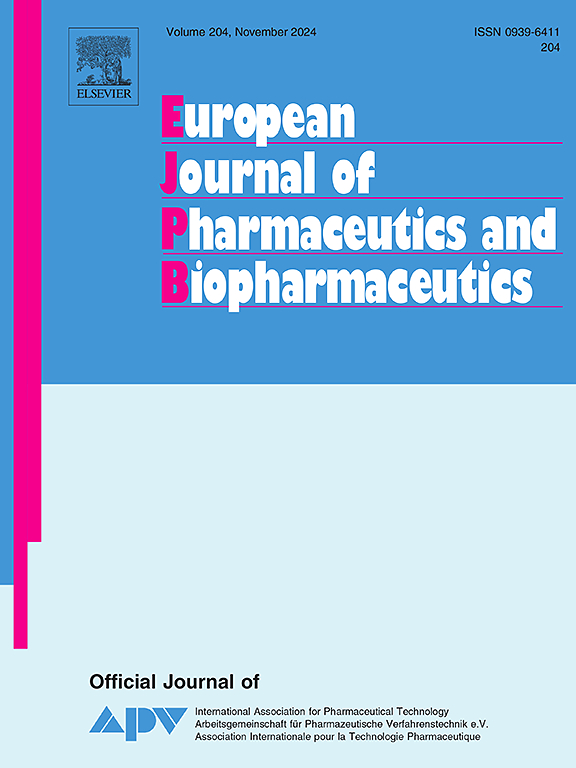一种用于精确治疗乳腺癌的盘绕式预靶向药物输送系统
IF 4.3
2区 医学
Q1 PHARMACOLOGY & PHARMACY
European Journal of Pharmaceutics and Biopharmaceutics
Pub Date : 2025-06-17
DOI:10.1016/j.ejpb.2025.114794
引用次数: 0
摘要
背景:抗体-药物偶联物(adc)是一种连接细胞毒性药物的抗体。为了优化adc的疗效,本研究基于两种合成的卷曲蛋白Zip1和Zip2的特异性相互作用,开发了一种预靶向给药系统。靶向载体由zip2融合的单链可变片段组成,毒性载体由Zip1通过SNAP-tag与细胞毒剂单甲基auristatin E结合组成。方法采用流式细胞术、荧光显微镜、细胞活力和凋亡测定、体外多重免疫荧光等技术对预靶向试剂的靶向活性进行评价。结果通过流式细胞术和荧光显微镜观察,预靶向复合物在乳腺癌细胞系中表现出特异性结合和内化。此外,在纳米摩尔浓度触发凋亡后,在表达抗原的细胞系中观察到细胞死亡。结论考虑到肿瘤环境的异质性和个体差异,分离“靶向”和“杀伤”步骤可以使靶向分子结合到不同的抗原上,然后应用zip1 -药物复合物,而不需要抗体工程。我们的研究强调了这种预靶向系统有效递送药物的潜力,为解决adc面临的挑战提供了一种有希望的策略,例如组织穿透性差、低蓄积和“靶向,非肿瘤”毒性。本文章由计算机程序翻译,如有差异,请以英文原文为准。

A coiled coil-based pre-targeting drug delivery system for precise treatment of breast cancer
Background
Antibody-drug conjugates (ADCs) consist of an antibody linked to a cytotoxic agent. To optimize the efficacy of ADCs, our study developed a pre-targeting drug delivery system based on the specific interaction between two synthetic coiled-coil proteins, Zip1 and Zip2. The targeting vehicle was composed of Zip2-fused single-chain variable fragments, while the toxic vehicle consisted of Zip1 conjugated to cytotoxic agent monomethyl auristatin E via SNAP-tag.
Methods
The targeting activities of the pre-targeting reagents were evaluated using various techniques, including flow cytometry, fluorescence microscopy, cell viability and apoptosis assays, and ex vivo multiplex immunofluorescence.
Results
The pre-targeting complexes demonstrated specific binding and internalization in breast cancer cell lines, as assessed by flow cytometry and fluorescence microscopy. Furthermore, cell death was observed in antigen-expressing cell lines upon triggering apoptosis at nanomolar concentrations.
Conclusions
Given the heterogeneous tumor environment and individual differences, separating the “targeting” and “killing” steps enables targeting molecules to bind to different antigens, followed by the application of the Zip1-drug complex without requiring antibody engineering. Our study highlights the potential of this pre-targeting system to efficiently deliver drugs, offering a promising strategy to address challenges faced by ADCs, such as poor tissue penetration, low accumulation, and “on-target, off-tumor” toxicity.
求助全文
通过发布文献求助,成功后即可免费获取论文全文。
去求助
来源期刊
CiteScore
8.80
自引率
4.10%
发文量
211
审稿时长
36 days
期刊介绍:
The European Journal of Pharmaceutics and Biopharmaceutics provides a medium for the publication of novel, innovative and hypothesis-driven research from the areas of Pharmaceutics and Biopharmaceutics.
Topics covered include for example:
Design and development of drug delivery systems for pharmaceuticals and biopharmaceuticals (small molecules, proteins, nucleic acids)
Aspects of manufacturing process design
Biomedical aspects of drug product design
Strategies and formulations for controlled drug transport across biological barriers
Physicochemical aspects of drug product development
Novel excipients for drug product design
Drug delivery and controlled release systems for systemic and local applications
Nanomaterials for therapeutic and diagnostic purposes
Advanced therapy medicinal products
Medical devices supporting a distinct pharmacological effect.

 求助内容:
求助内容: 应助结果提醒方式:
应助结果提醒方式:


